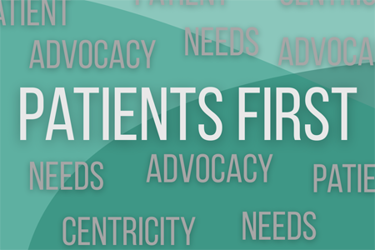Celebrating Clinical Trials Day, Part 1: Putting The Patient First
As told to Abby Proch, executive editor of guest columns, Clinical Leader

What better way to celebrate Clinical Trials Day 2025 than by first recognizing the role of the patient? Meet anyone in clinical research or read any pharmaceutical company bio, and you’ll almost always find mention of the patient. And rightfully so. Patients are the people for whom clinical research exists.
When we asked clinical research experts, "What is one challenge that you've successfully overcome as a clinical research professional, and how did it impact a specific trial or contribute to the wider industry of research?”, these leaders’ first thought was their experience with and approach to patient centricity. Whether they’ve had a firsthand encounter or been a patient themselves, these respondents have used their experience to drive improvements in their trials and across the wider research landscape.
 Laura Williams, MD, MPH, Chief Patient Officer, Ardelyx
Laura Williams, MD, MPH, Chief Patient Officer, Ardelyx
“During the turbulent days of the HIV/AIDS epidemic in the 1990s, while pursuing my infectious diseases fellowship, I faced a defining challenge that reshaped my planned career in clinical research. Caring for a patient in hospice with limited options, I assessed the benefit-risk profile of an innovative therapy that, at the time, was only available for compassionate use and made a shared, informed decision with my patient to utilize this new treatment. The results were amazing and greater than I could have ever imagined! The patient improved and was discharged from hospice care, and I took further steps to support his journey by assisting him in finding an apartment, enabling him to regain his independence.
This experience deeply influenced my approach to clinical drug development and reinforced the vital role of patient-centered research, access to care, and shared decision-making, emphasizing how innovative therapies can transform lives. It taught me that seeking out, understanding, and embracing innovation, grounded in empathy and patient connection, can lead to breakthroughs that reverberate beyond individual trials, inspiring a more hopeful and patient-centric approach to clinical research industry-wide.”
 Paul Lizzul, MD, Ph.D., MPH, M.B.A., Chief Medical Officer, AnaptysBio
Paul Lizzul, MD, Ph.D., MPH, M.B.A., Chief Medical Officer, AnaptysBio
“Early in my medical career, patient advocacy was often regarded as a procedural requirement rather than a fundamental component of our scientific approach. But after reviewing feedback from past participants and analyzing enrollment data across several trials, it became evident that addressing patient concerns regarding accessibility and trial logistics is crucial for enhancing trial enrollment and retention.
Through active engagement with patient advocacy groups and direct feedback from patients, we have significantly enhanced the design of clinical trials to be more patient-centric and accessible. This includes ensuring Wi-Fi access in clinical settings, decentralizing trials to enhance convenience, incorporating patient input in defining meaningful clinical endpoints, and accommodating patients’ family needs by allowing children to accompany them to appointments.
This paradigm shift has fostered a new perspective within the clinical research community, where patients are now recognized as vital research partners rather than mere subjects. Consequently, clinical research has become more effective and reflective of real-world needs. These inclusive efforts demonstrate that clinical research is most effective when it is built around the people it aims to help.”
 Anita Phung, MBBS, BSc(Hons), Medical Monitor, Lindus Health
Anita Phung, MBBS, BSc(Hons), Medical Monitor, Lindus Health
“My commitment to advancing women's health in clinical trials stems from personal experience as a Black, Asian, and minority ethnic (BAME) woman and practicing physician who recognizes the structural barriers women face in medical research.
Women disproportionately bear caregiving responsibilities, limiting their time and resources for trial participation. This systematic inequity creates research gaps that adversely affect women's healthcare outcomes. The current medical research framework fails to adequately address gender-specific obstacles. Until these structural inequities are acknowledged and addressed, women's health research will continue facing representation challenges that compromise healthcare quality.
A highlight of my career was when I partnered with Daye to validate its diagnostic tampon for human papillomavirus (HPV) detection — an asymptomatic infection potentially leading to cervical cancer. Together, we executed the STAMP study using paid social media for recruitment. We reached over 728,000 women, with 3,143 completing prescreening. Of these, 739 progressed to screening and 437 were enrolled in just five weeks. The decentralized, remote design of the study enabled wide engagement that may not have been otherwise possible.
Sponsors should embrace innovative approaches to lowering access barriers. Decentralized trials, wearable technology, and virtual consultations boost accessibility. By meeting women's specific needs, sponsors can create inclusive trials that better reflect the populations they aim to serve.”
 Stacy Wu, MD, Vice President, Head Of Clinical Research Biopharma, Sumitomo Pharma America
Stacy Wu, MD, Vice President, Head Of Clinical Research Biopharma, Sumitomo Pharma America
"In clinical trial design, our constant challenge is striking the balance between meeting FDA-defined clinical endpoints and understanding that patients may define success in ways that extend beyond these endpoints. While researchers and regulators might be focused on achieving a statistically significant improvement on a specific endpoint, patients and their caregivers may define success as the ability to maintain independence in activities of daily living, such as driving a car or cooking a meal. Partnering with advocacy groups has been essential for not only gaining these insights but also applying them. By prioritizing patients’ real-life short- and long-term goals alongside clinical value, we can ensure that endpoints better reflect patients’ realistic needs and what matters most to them."
 Kathryn D. Kelly, MD, PC, Physician Owner, Kelly Collaborative Medicine
Kathryn D. Kelly, MD, PC, Physician Owner, Kelly Collaborative Medicine
"The biggest challenge I successfully overcame as a clinical researcher is feeling that I would have to compromise my values to be a part of the process. My overall vision and mission professionally are to provide compassionate, comprehensive care to all my patients, while advocating for healthcare equity. I have embraced this in my practice, the work I do with the homeless, and with clinical research. This mission-driven purpose has led me to participate in trials that look to address issues in the African American community and diaspora by partnering with companies that share my values.
My decision to embrace my mission allowed me to make an impact on at least one life so far. I think this impacts the wider industry because this one life has as much worth as any other, and in the current climate, we have to stand up how we can for those that have been systematically marginalized and disproportionately negatively affected by lack of access to clinical studies and healthcare.”
 Kari Brown, Chief Medical Officer, Revolo Biotherapeutics
Kari Brown, Chief Medical Officer, Revolo Biotherapeutics
“We are developing a synthetic peptide, ‘1104, to treat allergic diseases such as eosinophilic esophagitis and atopic dermatitis. Intravenous administration of the drug was used for early-stage clinical studies to determine safety and to seek an initial clinical signal.
To transition to a more patient-focused dosage form, we collaborated closely with the CMC and research & development teams, accelerating efforts to create a subcutaneous formulation of the drug. This new formulation aims to provide a more patient-friendly option, improving ease of administration and enhancing overall patient experience. Additionally, we are working alongside the clinical trial site to optimize drug preparation processes and streamlining the timeline for clinical trial drug readiness.
This integrated approach of cross-functional collaboration, innovation, and operational efficiency is driving the project forward to ensure that the trial proceeds more efficiently. Our ultimate goal is to provide patients with a new treatment innovation that is safe, efficacious, and conveniently administered to enable chronic administration.”
Interested in what clinical research experts had to say about their experiences in other areas? Check out Part 2: Trial Optimization In Action and Part 3: Making The Most Of Resources.
